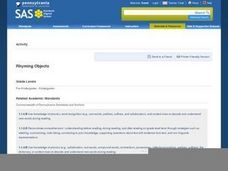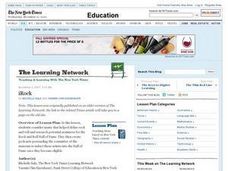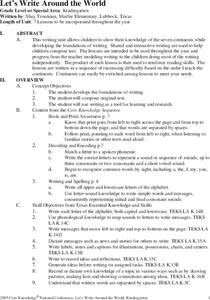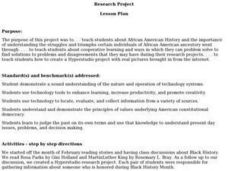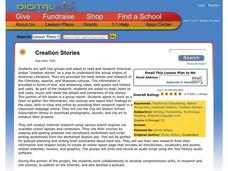Curated OER
Holy Mole
Students discover Mexican culture by reading and cooking. In this Central American History lesson, students read the book Holy Mole, and analyze the story by answering questions about plot, characters and even sound effects they...
Curated OER
Using Irregular Verbs
In this grammar activity, students read about using regular and irregular verbs in sentence writing. They then use what they learned to solve the 22 questions on the page. The answers are on the last page of the packet.
Curated OER
Rhyming Objects
Students explore language arts by reading Dr. Seuss stories in class. For this word play lesson, students identify the rhymes in both Dr. Seuss and Nursery Rhyme stories. Students utilize flash cards with rhymes written on them to play a...
Curated OER
Fin, Feathers, or Fur?
Students learn how to classify animals. In this animal characteristics lesson, students read Granddad's Animal Alphabet Book, brainstorm a list of different kinds of animals, and determine their characteristics; fur, feathers or scales....
Curated OER
iRock
Students explore, listen to and analyze songs that helped define rock and roll music. They read and discuss the article, "They're All Oldies, Dad Included." Research on contemporary artists is conducted and then the students choose who...
Curated OER
Let's Write Around the World
Students participate in an ongoing writing project about the seven world continents. In this continents writing lesson, students work on an interactive game to write about the seven continents. Students locate the continents on the map....
Curated OER
Narrative Pantomime: The Great Kapok Tree
Students pantomime the story of The Great Kapok Tree for younger students. For this The Great Kapok Tree lesson, students warm up with a game before volunteering for parts in the story. Students practice acting out the story in...
Curated OER
To Sum it all Up...
Students observe and demonstrate the process of summarizing text. They read and discuss the steps to summarize text, then in small groups read and summarize an article about frogs from "National Geographic" online. Independently they...
Curated OER
Sorting Out Homophones in Roald Dahl's
Students explore the concept of homophones. In this homophone instructional activity, students use a selection from the book Matilda to review homophones. Students use a web to identify homophones.
Curated OER
Literacy: Slowly, Slowly, Slowly Said the Sloth
Students explore language arts by analyzing a children's book in class. In this vocabulary instructional activity, students read the book Slowly, Slowly, Slowly... by Eric Carle. Students identify the characters, setting and plot of the...
Curated OER
Pioneer America: Pioneer Living
Fourth graders research pioneer life. In this pioneer lesson, 4th graders read the book Little House on the Prairie by Laura Ingalls Wilder and discuss what life was like for early pioneers. They research pioneers and show what they...
Curated OER
Research Project
Students fill out a form which asked the WHO, WHAT, WHEN, WHERE, and WHY about the person they were assigned to research, they gather their information from different web sites on Lightspan and Yahooligans. They create a HyperStudio and...
Curated OER
Woodland Animals and Their Habitat
Students explore the natural environment through a video and nature sounds tape. They keep journal's of the unit's activities and vocabulary terms. They play a web of interdependence game and compose a list of forest animals and write...
Curated OER
Instruments Used in Folk Music
In this music instructional activity, learners read short excerpts about the instruments that accompany folk music songs. They write 5-10 paragraphs about the use of the banjo and mandolin in folk music and about their differences. They...
Curated OER
The Froggy Page
Students investigate the cycle of life by observing tadpoles. In this biology lesson, students utilize the Internet to read stories, observe pictures, and listen to sounds of frogs. Students create a poster board collage...
Curated OER
Twisted Textbook
In this paragraph structure learning exercise, students read an excerpt about Europe and identify the sentences that focus on human characteristics as well as physical characteristics. Students rewrite the selection as two paragraphs...
Curated OER
Reflective Journaling
High schoolers write to influence positive change. For this service learning lesson, students reflect on their service learning experiences as they journal about sharing their time, talent, and treasures. High schoolers share their...
Curated OER
Adjective Lessons
Learning about comparative, superlative, and proper adjectives can involve hands-on activties.
Curated OER
Journey
Students complete a variety of enrichment activities that focus on the book, Journey, by Patricia MacLachlan. They create a photo album that shows their own family history.
Curated OER
Is It Irregular? - That is the Question
In this grammar worksheet, students read about using irregular and regular verbs in sentence writing. They then answer the 26 questions on the worksheet. The answers are on the last page.
Alabama Learning Exchange
Have You Seen My Mother?
Students listen to a read aloud of Janell Cannon's, Stellaluna as they examine how bats use their sense of smell. They examine the sense of smell by role playing as mother bats as identify different scents. They study bat facts at an...
Curated OER
Creation Stories
Students read and research American Indian creation stories as a way to understand the origins of American Literature. They conduct Internet research utilizing Internet search engines. They create an online report page as well as write...
Curated OER
Magic School Bus: The Wild Whale Watch Lesson Plan
Students research information about whales. In this early childhood lesson plan, students create an illustration of a whale to display in a sea scene in the classroom. Students then use the library and internet to research a whale of...
Curated OER
Signaling: merit badge
In this signaling worksheet, students use their workbook to answer short answer questions about different ways to send and receive messages. Students complete 6 questions total to get their merit badge.


